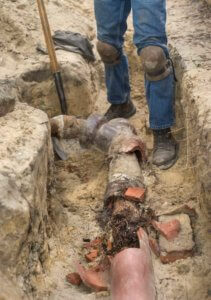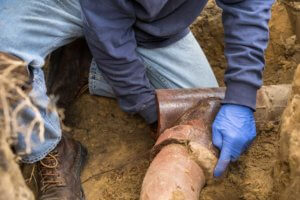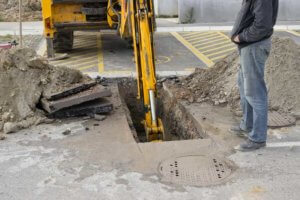How to Replace Sewer Line From House to Street
Looking for information on how to replace sewer line from the house to the street? If so, you’ve landed on the right page! In this short article, we’re going to go over why sewer lines fail, the best way to replace a sewer line, and how to dig a trench to replace your sewer line from house to street.
When you buy an older home, you buy older pipes, unless they’ve been replaced with PVC pipes. Homes built before the 1980s often have original pipes that are now reaching the end of their lifespan. While cast iron pipes can last up to 100 years under certain conditions, we’ve had to replace cast iron pipes after only 25 years. Cast iron pipes in coastal regions corrode faster due to salt in the air and groundwater. Clay and orangeburg pipes only last around 50-60 years.
While it’s certainly possible for a homeowner to replace the sewer line from the house to the street, it’s not going to be an easy job. It’s going to require both knowledge and manpower because it needs to be done right, or it won’t work properly. If that happens, you’ll need to pay a professional to come in and fix it.
What is a sewer line?
Wastewater is removed from your home via 2-inch drain pipes running from sinks, showers, bathtubs, and toilets into the building’s 4-inch main sewer line located under the slab. From there it’s transported via one lateral line either to a septic tank on your property or to the city’s main line in the street. There will usually be at least two cleanouts for easy access to the line in case of a clog.

Why do sewer lines fail?
Over time, things like soil settlement and thaw-freeze cycles will cause sewer lines to move slightly. This slight movement can cause leaks in older sewer lines. Once there’s a leak, water empties into the soil. This can cause the soil to erode, causing the sewer line to destabilize and move even more. Cracks in sewer lines also allow tree roots – looking for water and nutrients – to get inside the pipe and start growing. If they’re not removed, they will eventually break the pipe.
Read also: Common Sewer Stack Problems
When do sewer lines need to be replaced?
Some sewer pipes last longer than others. Cast iron sewer pipes can last up to 100 years, however we have seen some that are cracked and deteriorated after as little as 25 years. However, clay and orangeburg pipes will only last around 50-60 years. The truth is that pipes can develop problems at any time for a variety of reasons that have nothing to do with their age.
How do I know if my sewer line from house to street needs replacing?
The only way to know for sure if your sewer line needs to be replaced is to contact a sewer repair professional and ask them to perform a CCTV sewer camera inspection. They’ll be able to see what’s going on inside the pipe and, if there is any damage, they’ll be able to offer a solution. A sewer camera inspection is a non-destructive, 30-minute procedure.

What’s the best way to replace a sewer line from your house to the street?
It depends on the problem. That’s why a sewer camera inspection is always the first step.
Unless the problem pipe is back-pitched or has collapsed, it can probably be replaced using a minimally-invasive trenchless sewer repair method called pipe bursting. Otherwise – that is, if it’s back-pitched or has collapsed – it will need to be replaced via conventional sewer replacement which involves digging a trench.
If you’re going to attempt to do this yourself, don’t forget that you’ll need a permit from the city and you’ll need to follow certain rules set by the government. Since these vary from state to state, you’ll need to check with the local authorities in your area.
Replacing a sewer line yourself can save you quite a bit of money. However, as we mentioned above, it’s not an easy job because you’ll be both digging the trench and replacing the pipe. While digging a trench isn’t technically difficult, it’s physically demanding. It will take you some time to do it, especially if the soil is dense and there are a lot of big tree roots. Sewer lines in cold climates may be up to 6 feet deep because they’re below the frost line. Also, if you have a sewer line problem during the winter, you’re going to have a lot of trouble digging into frozen ground.
Although you aren’t required to, you should plan on following OSHA’s safety guidelines. For example, you’ll need trench shields if the trench is 5 feet or deeper.
Learn more about: How To Fix A Sewer Leak In Your Yard

DIY: How to dig a trench to replace your sewer line from house to street
First step
Your first step will be to find the sewer line. A professional CCTV sewer camera inspection can help with this as the camera has a radio transmitter. When you find the sewer line, do something to mark its entire length. Accuracy here is important. You don’t want to start digging in the wrong spot.
Second step
Now you’ll need to locate the utility lines. You can do this by simply calling 811 on your phone and asking them to come out and show you where everything is located. Of course, they won’t be able to tell you the location of anything that’s homeowner-installed. For example, sprinkler systems.
Third Step
You might need a permit or you might not. Call the city to find out. Also, ask what you’ll need to do in order to ensure that your work is up to code. Sometimes, the city will want to come out and inspect the repair before you fill in the trench.
Fourth Step
If necessary, use either an 8-pound sledgehammer or some type of electric tool to break through any concrete obstructions such as sidewalks, driveways, etc.
Fifth Step
Now it’s time to dig the trench. Dig straight down until you reach the pipe. This could be anywhere from 1.5-6 feet. After you reach the pipe, start digging sideways in order to create some room. As you’re digging, you might run into roots that will need to be cut. If they’re big, you’ll need a chainsaw. Once you reach the pipe, dig around it to clear away the soil.
Always cover and guard the trench until the repair is complete. You don’t want children or pets falling into it.
Sixth Step
Disconnect/cut the pipe from the house main and from the city sewer. This is usually at the house’s main cleanout and the property line cleanout. Remove the old pipe, install the new pipe, and then reconnect to the rest of the system.
Seventh Step
Once your repair has been inspected and approved, you can fill in the trench, compacting the soil as you go.
As we mentioned above, it’s certainly possible for a homeowner to perform sewer line replacement or sewer line repair. However, it’s definitely not an easy job. When you replace the sewer line yourself you run the risk of causing even more damage. If that happens, you’ll need to hire a sewer repair professional to fix it.
Also, it’s possible that your sewer line doesn’t need to be replaced. A repair using a minimally-invasive trenchless sewer pipe repair method such as sewer pipe lining might be all you need.




